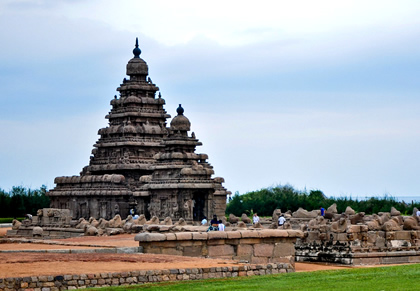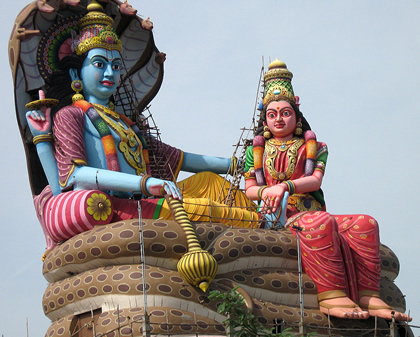World History
Tamil is a Dravidian language group that originated in southern India and is not linked to the northern Aryan language group. Tamil speakers are found in Tamilnadu, the region surrounded by Kerela, Karnataka, and Pradesh and parts of present-day Sri Lanka. Historically, the two largest and most influential Tamil cities were Madras and Madura.
Intense trade and military expansion resulted in Tamil cultural expansion from the second century to the 10th century. At the core of Tamil cultural identity is the Tamil language. As early as the end of the third century, Tamil script and Tamil as a distinct Dravidian language are documented.
Thus literature and poetry are at the core of culture in this period. However religion, another important aspect of Tamil culture, informed art in the form of painting, sculpture, and architecture.
The fourth century began after the end of the classical period in Tamil literature and was also the beginning of the rule of Pallavas, which would dominate until the 10th century. While this dynasty is not of Tamil origin, the integration of this dynasty into Tamil society transformed the cultural identity.
Pallavas encouraged the worship of Shiva and Vishnu and built lavish temples to honor them. They modeled their society after the great Aryan northern dynasties, the Mauras and Guptas. The Pallava kingdom marked the beginning of the Bakthi poetry movement.
The greatest collection of religious poetry that is indicative of this movement is the Thirumurai, which includes hymns of Appar, Sampanthar, Suntharar, and Manikkavasagar’s mystical poem Thiruvacagam.
The Chola kingdom (c.985–1300) began with ascension of Raja Raja I (985–1014) and the installation of his son Rajendra I. Their power and the crystallization of Tamil cultural identity provided a rich environment to facilitate cultural output. The Cholas were able to conquer vast amounts of territory as far as Malaysia.
As they conquered these lands they erected glorious temples and statues including bronzes of the dancing Lord Natarajan. By the 10th century the Cholas had a well-established trade relationship with China, which aided in enriching cultural connections.
Under the Cholas, epic poetry was written by three great poets: Kampan, Ottakkootar, and Pukalenthi. The masterpiece of Tamil literature from this period was poetry created from stories written by Kamban.
Ramayanam (epics) were told in temples and were a part of worship. These were episodic public works performed in the temple, and in many ways were a reaction to the Bakthi movement.
Avvaiyar was a popular Tamil female poet, whose canon of expansive work spanned many topics, including spirituality and wisdom, which was largely popular among the people.
By the 13th century the Pandyas grew in political importance and displaced the Cholas as the dominant power. The Pandyas were highly proficient in trade and education. They controlled the pearl fisheries between the southeastern India coast and Sri Lanka, which produced the finest quality of pearls.
The Pandyas kings were known as far as Syria. The Nayaka period (c. 1336) was the instillation of the Nayaks of the Vijayanagara empire after the gradual spread of Muslim political authority in South Asia beginning in 711 with the Arabs and later, Turko-Afghans and Persians.
The decline of Tamil literature ends with the Nayaka Viceroy period under the hegemony of Sanskrit and Tugulu languages. However there was resurgence in Tamil literature in the 16th and 17th centuries.
Tamil culture from the seventh century until the mid-15th century was influenced heavily by religious devotion in the form of art, architecture, and sculpture. It was also in this period that Tamil literature underwent many transformations. This period provided the foundation for later articulations of Tamil identity.
- Bhakti Movements (devotional Hinduism)
Bhakti Movements (Devotional Hinduism) The word bhakti is derived from a Sanskrit word for “sharing.†It was used to describe a new type of path to moksha (“liberation from the cycle of reincarnationsâ€). Bhakti devotees (bhaktas)...
- Chola Kingdom
Chola Kingdom The Chola kingdom was a medieval Indian state, which saw most of southern India being brought under a united government for the first time. At its greatest extent, Chola covered not just the south of India but also Sri Lanka, peninsular...
- Dvaravati
Dvaravati map The Mon kingdom of Dvaravati (also called Siam) flourished in what is now Thailand from the sixth century c.e. to around the 11th century. The kingdom covered the political area of Nakhon Pathom (west of present-day Bangkok), U-Thong, and...
- History Of Singapore
History of Singapore. This is a brief history of the Asian nation of Singapore. Whatever you do, don't chew gum in public here! They will take you out and flog you. Wikpedia notes, "The Republic of Singapore (Simplified Chinese: ??????; Pinyin: X?nji?p?...
- History Of Sri Lanka
History of Sri Lanka. This is a hisory of the Asian nation of Sri Lanka. This is an ancient land. However, this essay focuses the most on the current conflict between the Tamil Tiger rebels and the Sri Lankan government. Wikipedia notes, "The Democratic...
World History
Tamil Culture
 |
| Tamil Culture |
Tamil is a Dravidian language group that originated in southern India and is not linked to the northern Aryan language group. Tamil speakers are found in Tamilnadu, the region surrounded by Kerela, Karnataka, and Pradesh and parts of present-day Sri Lanka. Historically, the two largest and most influential Tamil cities were Madras and Madura.
Intense trade and military expansion resulted in Tamil cultural expansion from the second century to the 10th century. At the core of Tamil cultural identity is the Tamil language. As early as the end of the third century, Tamil script and Tamil as a distinct Dravidian language are documented.
Thus literature and poetry are at the core of culture in this period. However religion, another important aspect of Tamil culture, informed art in the form of painting, sculpture, and architecture.
  |   |
The fourth century began after the end of the classical period in Tamil literature and was also the beginning of the rule of Pallavas, which would dominate until the 10th century. While this dynasty is not of Tamil origin, the integration of this dynasty into Tamil society transformed the cultural identity.
Pallavas encouraged the worship of Shiva and Vishnu and built lavish temples to honor them. They modeled their society after the great Aryan northern dynasties, the Mauras and Guptas. The Pallava kingdom marked the beginning of the Bakthi poetry movement.
The greatest collection of religious poetry that is indicative of this movement is the Thirumurai, which includes hymns of Appar, Sampanthar, Suntharar, and Manikkavasagar’s mystical poem Thiruvacagam.
The Chola kingdom (c.985–1300) began with ascension of Raja Raja I (985–1014) and the installation of his son Rajendra I. Their power and the crystallization of Tamil cultural identity provided a rich environment to facilitate cultural output. The Cholas were able to conquer vast amounts of territory as far as Malaysia.
As they conquered these lands they erected glorious temples and statues including bronzes of the dancing Lord Natarajan. By the 10th century the Cholas had a well-established trade relationship with China, which aided in enriching cultural connections.
 |
| Tamil statue |
Under the Cholas, epic poetry was written by three great poets: Kampan, Ottakkootar, and Pukalenthi. The masterpiece of Tamil literature from this period was poetry created from stories written by Kamban.
Ramayanam (epics) were told in temples and were a part of worship. These were episodic public works performed in the temple, and in many ways were a reaction to the Bakthi movement.
Avvaiyar was a popular Tamil female poet, whose canon of expansive work spanned many topics, including spirituality and wisdom, which was largely popular among the people.
By the 13th century the Pandyas grew in political importance and displaced the Cholas as the dominant power. The Pandyas were highly proficient in trade and education. They controlled the pearl fisheries between the southeastern India coast and Sri Lanka, which produced the finest quality of pearls.
The Pandyas kings were known as far as Syria. The Nayaka period (c. 1336) was the instillation of the Nayaks of the Vijayanagara empire after the gradual spread of Muslim political authority in South Asia beginning in 711 with the Arabs and later, Turko-Afghans and Persians.
The decline of Tamil literature ends with the Nayaka Viceroy period under the hegemony of Sanskrit and Tugulu languages. However there was resurgence in Tamil literature in the 16th and 17th centuries.
Tamil culture from the seventh century until the mid-15th century was influenced heavily by religious devotion in the form of art, architecture, and sculpture. It was also in this period that Tamil literature underwent many transformations. This period provided the foundation for later articulations of Tamil identity.
- Bhakti Movements (devotional Hinduism)
Bhakti Movements (Devotional Hinduism) The word bhakti is derived from a Sanskrit word for “sharing.†It was used to describe a new type of path to moksha (“liberation from the cycle of reincarnationsâ€). Bhakti devotees (bhaktas)...
- Chola Kingdom
Chola Kingdom The Chola kingdom was a medieval Indian state, which saw most of southern India being brought under a united government for the first time. At its greatest extent, Chola covered not just the south of India but also Sri Lanka, peninsular...
- Dvaravati
Dvaravati map The Mon kingdom of Dvaravati (also called Siam) flourished in what is now Thailand from the sixth century c.e. to around the 11th century. The kingdom covered the political area of Nakhon Pathom (west of present-day Bangkok), U-Thong, and...
- History Of Singapore
History of Singapore. This is a brief history of the Asian nation of Singapore. Whatever you do, don't chew gum in public here! They will take you out and flog you. Wikpedia notes, "The Republic of Singapore (Simplified Chinese: ??????; Pinyin: X?nji?p?...
- History Of Sri Lanka
History of Sri Lanka. This is a hisory of the Asian nation of Sri Lanka. This is an ancient land. However, this essay focuses the most on the current conflict between the Tamil Tiger rebels and the Sri Lankan government. Wikipedia notes, "The Democratic...
